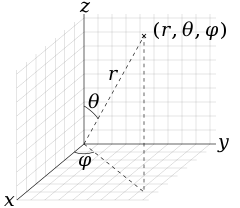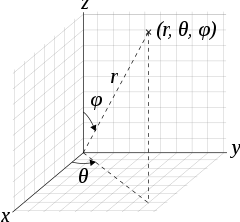
In mathematics, a spherical coordinate system is a coordinate system for three-dimensional space where the position of a given point in space is specified by three real numbers: the radial distance r along the radial line connecting the point to the fixed point of origin; the polar angle θ between the radial line and a polar axis; and the azimuthal angle φ as the angle of rotation of the radial line around the polar axis.[a] (See graphic re the "physics convention".) Once the radius is fixed, the three coordinates (r, θ, φ), known as a 3-tuple, provide a coordinate system on a sphere, typically called the spherical polar coordinates.
The radial distance from the fixed point of origin is also called the radius, or radial line, or radial coordinate. The polar angle may be called inclination angle, zenith angle, normal angle, or the colatitude. The user may choose to ignore the inclination angle and use the elevation angle instead, which is measured upward between the reference plane and the radial line—i.e., from the reference plane upward (towards to the positive z-axis) to the radial line. The depression angle is the negative of the elevation angle. (See graphic re the "physics convention"—not "mathematics convention".)
Both the use of symbols and the naming order of tuple coordinates differ among the several sources and disciplines. This article will use the ISO convention[1] frequently encountered in physics, where the naming tuple gives the order as: radial distance, polar angle, azimuthal angle, or . (See graphic re the "physics convention".) In contrast, the conventions in many mathematics books and texts give the naming order differently as: radial distance, "azimuthal angle", "polar angle", and or —which switches the uses and meanings of symbols θ and φ. Other conventions may also be used, such as r for a radius from the z-axis that is not from the point of origin. Particular care must be taken to check the meaning of the symbols.

According to the conventions of geographical coordinate systems, positions are measured by latitude, longitude, and height (altitude). There are a number of celestial coordinate systems based on different fundamental planes and with different terms for the various coordinates. The spherical coordinate systems used in mathematics normally use radians rather than degrees; (note 90 degrees equals π/2 radians). And these systems of the mathematics convention may measure the azimuthal angle counterclockwise (i.e., from the south direction x-axis, or 180°, towards the east direction y-axis, or +90°)—rather than measure clockwise (i.e., from the north direction x-axis, or 0°, towards the east direction y-axis, or +90°), as done in the horizontal coordinate system.[2] (See graphic re "mathematics convention".)
The spherical coordinate system of the physics convention can be seen as a generalization of the polar coordinate system in three-dimensional space. It can be further extended to higher-dimensional spaces, and is then referred to as a hyperspherical coordinate system.
To define a spherical coordinate system, one must designate an origin point in space, O, and two orthogonal directions: the zenith reference direction and the azimuth reference direction. These choices determine a reference plane that is typically defined as containing the point of origin and the x– and y–axes, either of which may be designated as the azimuth reference direction. The reference plane is perpendicular (orthogonal) to the zenith direction, and typically is desiginated "horizontal" to the zenith direction's "vertical". The spherical coordinates of a point P then are defined as follows:
The sign of the azimuth is determined by designating the rotation that is the positive sense of turning about the zenith. This choice is arbitrary, and is part of the coordinate system definition. (If the inclination is either zero or 180 degrees (= π radians), the azimuth is arbitrary. If the radius is zero, both azimuth and inclination are arbitrary.)
The elevation is the signed angle from the x-y reference plane to the radial line segment OP, where positive angles are designated as upward, towards the zenith reference. Elevation is 90 degrees (= π/2 radians) minus inclination. Thus, if the inclination is 60 degrees (= π/3 radians), then the elevation is 30 degrees (= π/6 radians).
In linear algebra, the vector from the origin O to the point P is often called the position vector of P.
Several different conventions exist for representing spherical coordinates and prescribing the naming order of their symbols. The 3-tuple number set denotes radial distance, the polar angle—"inclination", or as the alternative, "elevation"—and the azimuthal angle. It is the common practice within the physics convention, as specified by ISO standard 80000-2:2019, and earlier in ISO 31-11 (1992).
As stated above, this article describes the ISO "physics convention"—unless otherwise noted.
However, some authors (including mathematicians) use the symbol ρ (rho) for radius, or radial distance, φ for inclination (or elevation) and θ for azimuth—while others keep the use of r for the radius; all which "provides a logical extension of the usual polar coordinates notation".[3] As to order, some authors list the azimuth before the inclination (or the elevation) angle. Some combinations of these choices result in a left-handed coordinate system. The standard "physics convention" 3-tuple set conflicts with the usual notation for two-dimensional polar coordinates and three-dimensional cylindrical coordinates, where θ is often used for the azimuth.[3]
Angles are typically measured in degrees (°) or in radians (rad), where 360° = 2π rad. The use of degrees is most common in geography, astronomy, and engineering, where radians are commonly used in mathematics and theoretical physics. The unit for radial distance is usually determined by the context, as occurs in applications of the 'unit sphere', see applications.
When the system is used to designate physical three-space, it is customary to assign positive to azimuth angles measured in the counterclockwise sense from the reference direction on the reference plane—as seen from the "zenith" side of the plane. This convention is used in particular for geographical coordinates, where the "zenith" direction is north and the positive azimuth (longitude) angles are measured eastwards from some prime meridian.
Note: Easting (E), Northing (N), Upwardness (U). In the case of (U, S, E) the local azimuth angle would be measured counterclockwise from S to E.
Any spherical coordinate triplet (or tuple) specifies a single point of three-dimensional space. On the reverse view, any single point has infinitely many equivalent spherical coordinates. That is, the user can add or subtract any number of full turns to the angular measures without changing the angles themselves, and therefore without changing the point. It is convenient in many contexts to use negative radial distances, the convention being , which is equivalent to or for any r, θ, and φ. Moreover, is equivalent to .
When necessary to define a unique set of spherical coordinates for each point, the user must restrict the range, aka interval, of each coordinate. A common choice is:
But instead of the interval [0°, 360°), the azimuth φ is typically restricted to the half-open interval (−180°, +180°], or (−π, +π ] radians, which is the standard convention for geographic longitude.
For the polar angle θ, the range (interval) for inclination is [0°, 180°], which is equivalent to elevation range (interval) [−90°, +90°]. In geography, the latitude is the elevation.
Even with these restrictions, if the polar angle (inclination) is 0° or 180°—elevation is −90° or +90°—then the azimuth angle is arbitrary; and if r is zero, both azimuth and polar angles are arbitrary. To define the coordinates as unique, the user can assert the convention that (in these cases) the arbitrary coordinates are set to zero.
To plot any dot from its spherical coordinates (r, θ, φ), where θ is inclination, the user would: move r units from the origin in the zenith reference direction (z-axis); then rotate by the amount of the azimuth angle (φ) about the origin from the designated azimuth reference direction, (i.e., either the x– or y–axis, see Definition, above); and then rotate from the z-axis by the amount of the θ angle.

Just as the two-dimensional Cartesian coordinate system is useful—has a wide set of applications—on a planar surface, a two-dimensional spherical coordinate system is useful on the surface of a sphere. For example, one sphere that is described in Cartesian coordinates with the equation x2 + y2 + z2 = c2 can be described in spherical coordinates by the simple equation r = c. (In this system—shown here in the mathematics convention—the sphere is adapted as a unit sphere, where the radius is set to unity and then can generally be ignored, see graphic.)
This (unit sphere) simplification is also useful when dealing with objects such as rotational matrices. Spherical coordinates are also useful in analyzing systems that have some degree of symmetry about a point, including: volume integrals inside a sphere; the potential energy field surrounding a concentrated mass or charge; or global weather simulation in a planet's atmosphere.

Three dimensional modeling of loudspeaker output patterns can be used to predict their performance. A number of polar plots are required, taken at a wide selection of frequencies, as the pattern changes greatly with frequency. Polar plots help to show that many loudspeakers tend toward omnidirectionality at lower frequencies.
An important application of spherical coordinates provides for the separation of variables in two partial differential equations—the Laplace and the Helmholtz equations—that arise in many physical problems. The angular portions of the solutions to such equations take the form of spherical harmonics. Another application is ergonomic design, where r is the arm length of a stationary person and the angles describe the direction of the arm as it reaches out. The spherical coordinate system is also commonly used in 3D game development to rotate the camera around the player's position[4]
Instead of inclination, the geographic coordinate system uses elevation angle (or latitude), in the range (aka domain) −90° ≤ φ ≤ 90° and rotated north from the equator plane. Latitude (i.e., the angle of latitude) may be either geocentric latitude, measured (rotated) from the Earth's center—and designated variously by ψ, q, φ′, φc, φg—or geodetic latitude, measured (rotated) from the observer's local vertical, and typically designated φ. The polar angle (inclination), which is 90° minus the latitude and ranges from 0 to 180°, is called colatitude in geography.
The azimuth angle (or longitude) of a given position on Earth, commonly denoted by λ, is measured in degrees east or west from some conventional reference meridian (most commonly the IERS Reference Meridian); thus its domain (or range) is −180° ≤ λ ≤ 180° and a given reading is typically designated "East" or "West". For positions on the Earth or other solid celestial body, the reference plane is usually taken to be the plane perpendicular to the axis of rotation.
Instead of the radial distance r geographers commonly use